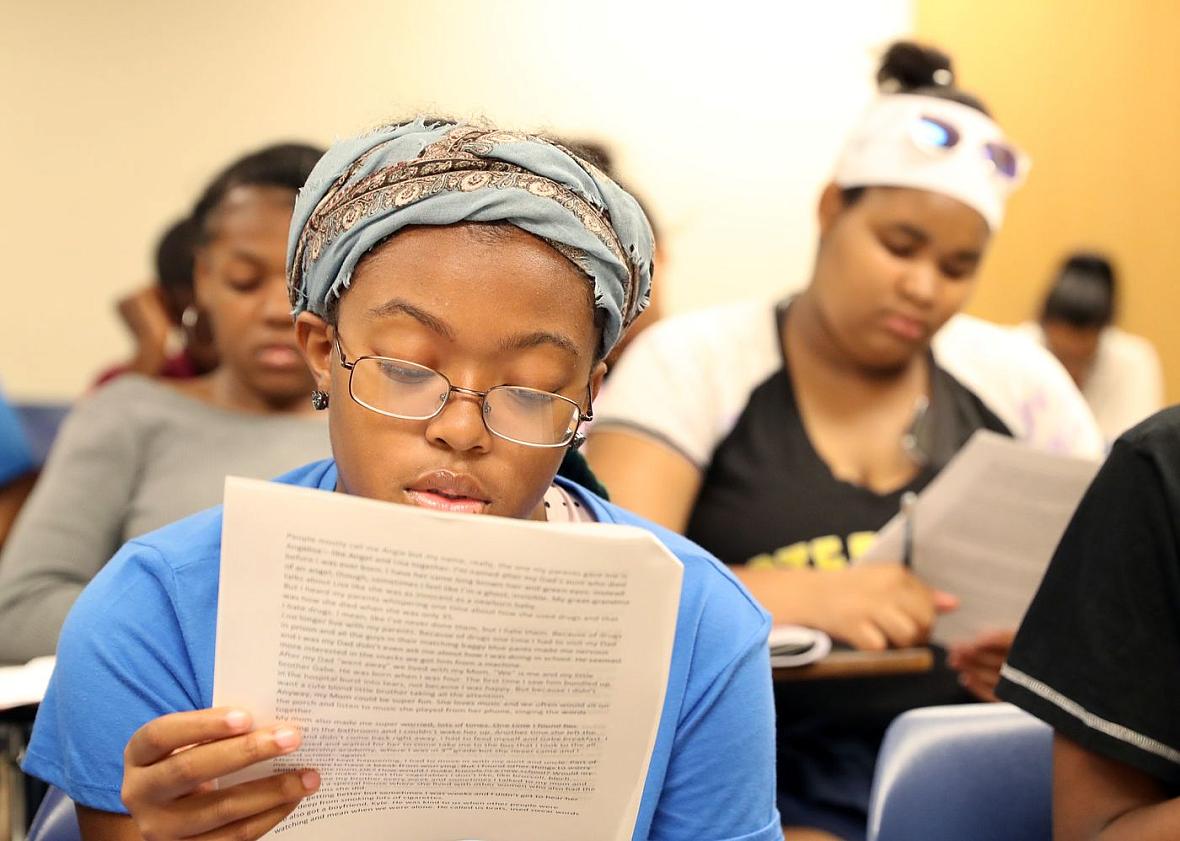Students with bright futures pen stories about fictional Cleveland teens who face tough choices: Dear Cleveland
This reporting is supported by the University of Southern California Center for Health Journalism National Fellowship.

Cailah Porter, 15, reads over an example of a short story as she and fellow Upward Bound students prepare to work in groups to create characters who will face dilemmas. Porter, an honors student who plays basketball and participates in debate and math clubs at Whitney Young Leadership Academy, co-created a character named C'arlos who decides whether to live on the streets or return to foster care.
CLEVELAND, Ohio --Kids here face some tough choices.
As a part of our Dear Cleveland project, where we highlight young perspectives, we wanted to find a way to explore those decisions.
To do that, we worked last summer with more than a dozen students who participated in the Upward Bound Program at Case Western Reserve University. It’s a pre-college program the university has operated since 1966, and this year it served more than 100 Cleveland public schools students who aspire to attend college.
We didn’t ask students to share personal stories. Instead students worked in small groups to create fictional characters, with physical descriptions and back stories. We read examples from the popular novel “The Hate U Give” by Angie Thomas to explore what makes a character compelling.
The students then co-wrote short stories about dilemmas their characters faced. At the end of the story, the reader gets to pick one of two choices — we call them Decision A and Decision B — to see what the outcome of each choice would be.
The class was led by Meryl Johnson, a retired Cleveland schools teacher with 40 years of classroom experience who is now a member of the Ohio Board of Education. Johnson’s job with the program is to work with the students to sharpen their writing skills. She prompted the students to use literary devices, such as simile and metaphor, in the stories.
The characters and stories in many ways reflect what they or their friends have experienced growing up in Cleveland, the students said. In one story, 16-year-old “Mo” contemplates suicide. His relationship with his mother is strained and he’s still mourning his father, who was killed in the street. The case is unsolved.
A hand-written draft of a story about a fictional Cleveland teen named "Elizabeth."
In two other stories, high schoolers “Audrey” and “Elizabeth,” face choices of being bullied or beaten up or joining groups of girls that put them in danger of being hurt or arrested.
Some interesting patterns emerged. Most of the characters didn’t look like the students who created them. They were often depicted as light-skinned or mixed race with green or hazel eyes, a detail that some students felt added depth to the characters.
All four characters were born somewhere else — Cincinnati, Detroit, California — and ending up having to live in Cleveland. In several of the stories, no matter what choice is made, the outcome is bad.
These fictional stories, though, don’t paint a full picture of life for Cleveland kids. The high school students who created the characters and stories run track and play golf. They are members of their schools’ drama clubs and debate teams and math clubs. They love telling jokes and spending time with their families.
As Johnson said, “they all have dreams, they have skills and they have possibilities.”
The stories, in some ways, may mirror the parts of life students think people might want to read about.
When asked questions about their literary choices, some of the students told us they wrote what they knew, what they experienced or what they saw in their environment. Others said they thought the life-or-death details simply made the stories more compelling or dramatic for readers.
Brice Peake, a sophomore at Whitney M. Young Leadership Academy, said society in general tends to focus a lot on violence in the African-American community when in reality it’s only a fragment of the experience.
The upsides to having more melanin, he said, such as the “heap of positivity” African-Americans bring to society’s table, don’t get the same attention.
“We’re just drowned out by people’s predetermined predictions of us before they really get familiar with our personal construct,” he said. “I think I have a harder time trying to change people’s minds about my ‘negative persona’ than the struggle I face in the streets of violence.”
Stories like these, we feel, are worth reading and hopefully spark discussion. The exercise gives us a small peek into what some young people in Cleveland are up against. And a reminder that many of them succeed in spite of it.
[This story was originally published by Cleveland.com.]


